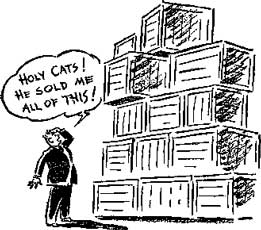 The year was 1947. Harry S. Truman was president, Chuck Yeager broke the sound barrier, and on October 17, 1947, the Manufacturers’ Agents National Association joined the community of not-for-profit trade associations.
The year was 1947. Harry S. Truman was president, Chuck Yeager broke the sound barrier, and on October 17, 1947, the Manufacturers’ Agents National Association joined the community of not-for-profit trade associations.
To celebrate our 70th MANAversary year, each Agency Sales magazine through October will include a “blast from the past” article from the early issues of The AGENT and Representative magazine, which eventually became Agency Sales.
These nostalgic looks back at how our counterparts from seven decades ago conducted their businesses and their lives are really eye-opening, in some cases because they conducted their business so differently from a modern manufacturers’ representative, and in some cases because it seems that nothing has changed in all that time. Enjoy!
The Selling Parade
By Chas B. Roth
(Reprinted from October 1949 The AGENT and Representative magazine)
Keep Chart in Front
I know it’s customary for men who call themselves and believe themselves “practical men” to pooh-pooh anything savoring of academic classification in salesmanship.
“All this talk about salesmanship is a lot of bunk,” such a man told me recently. “All you have to do to make sales is just make ’em.”
All well and good. But what if you don’t know how to “just make ’em,” and what if you want to know why you do certain things to get certain effects? Then you have to go to organized knowledge, and the knowledge of salesmanship is as carefully organized, after 50 years of trial and error, and classifying, and experimenting as the knowledge of any other of the sciences.
To me it seems pretty silly for a man to renounce what has been proved to work; almost as silly as relying when he is sick upon a voodoo man or old wives’ herbs.
 The smarter men in the selling business are not above learning the rules, and keeping the rules in front of them as they work.
The smarter men in the selling business are not above learning the rules, and keeping the rules in front of them as they work.
One man of my acquaintance, for instance, says that he can’t sell unless he keeps the chart of selling in front of him every day. He, as a matter of fact, has the chart in printed form, carries it around in his billfold, looks at it several times during the day, checks each interview on it to see why and how he sold or did not sell.
The chart of a sale is simple, for selling is simple. There are only eight steps. Maybe you wouldn’t mind having me go over the chart in a quickie here. All right.
First step — the PREAPPROACH — what you do before you make your call. Next — the APPROACH. What you say and do during first 10 seconds in prospect’s presence. This is followed by the INTEREST-BUILDING step, consisting of sales talk and demonstration, and, if properly taken, it leads to the DESIRE step, in which you make ’em want it.
After that comes CONVICTION, during which you make them believe in you, in what you say, and you are ready for the close. But you are not done yet. One more step remains. It is the POSTCLOSE, in which you nail down what you have said, guarantee your sale will stay closed and not open up and result in a cancellation or unhappy customer.
Eight steps is all. Take each properly, in order, and you sell; omit one, bungle it, and you may sell, but the chances are you will not.
Compare and Sell
He said it over 50 years ago and it is as true today as it was when the thought was only minutes old: “When you sell you compare.” Who said that? John H. Patterson, founder of modern salesmanship, greatest contributor, perhaps, to the science of distribution in the history of business.
Original thinker was this Patterson; a man who beat his own trails; as much of a pioneer as Zebulon Pike or Christopher Columbus, because he also was a discoverer.
What he discovered benefits you today — that salesmanship is a science and that there is a better way to sell than the way which comes naturally to a man.
What Patterson means by saying that selling is comparing is simple: you compare a man’s lot with your goods and without them, and show him how he benefits. What else is there to selling except that?
Think about this simple description of selling — selling is comparing. Think often about it. And the next time you are talking to a prospect about your line or your ideas, remember to use comparisons more. It is one of the soundest axioms of salesmanship I have ever known, sound and useful. You can use it yourself every day you live.
Impressions First
The moment he came into the realm of your consciousness, you knew you were talking to no ordinary individual. He was an entity. And in a world where nonentities outnumber the entities about 100 to 1, he made a grand impression.
 He was a salesman, one of the best I have ever known, and for years he was touted as a man whose income was double that of the President of the United States. And I have no reason for doubting these tales, for he had what the boys call “the stuff.”
He was a salesman, one of the best I have ever known, and for years he was touted as a man whose income was double that of the President of the United States. And I have no reason for doubting these tales, for he had what the boys call “the stuff.”
But his success was not accidental. He was a scientist in everything he did, I haven’t the space to tell you all about his system, but I think it might give you an idea if I told you how he created the right impression.
He had discovered that most salesmen do not know how to make a grand entrance. They slink in. That is wrong, he figures. So he studied how he could make an entrance into a man’s office in a way that no man could ever forget.
He spent hours practicing on how to open a door, how to take the first step across the threshold, how to make the greeting most effective. He didn’t sidle in or slink in. No sir. He opened the door with a bit of a flourish — eagerly — but he held his hand on the knob. Then he took his first step, and stood there framed by the doorway. Then he smiled. It was impressive. It was unforgettable. Also it was pleasing. He had your attention — your favorable attention — from the first. And because he was in on the right basis, selling for him was easy. His impression was right. Is yours?
Asking Enough
Sales managers and salesmen give a lot of thought to the question of how much they should sell a prospect. Shall they go the limit, sell him as much as they can, or shall they judge when they have sold him enough?
Arguments abound. If you sell a man too much, you make an enemy; he gets stuck with your goods, and loses money, then you can wipe him off as a customer. If you don’t sell him enough, a competitor will step in, and you will lose sales and money that are rightfully yours. So what’s a poor guy in selling to do?
The best answer I know is from a salesman in Texas; a topnotch man who has been a big money earner for years.
His philosophy is simple: Load up every customer to the guards; sell him more than his judgment or yours tells you he can assimilate.
Sounds suicidal, doesn’t it? It would be that if it were not for this man’s next step: “Then,” he says, “pitch in and help your dealer to sell what you have sold him.”
That’s what he does. He makes his sale and then he says, “Now, you might have a little trouble disposing of all these goods, so I reckon you and I had better get our heads together and figure out some merchandising plans.”
So they do. The salesman educates his dealer in merchandising, advertising, window display. In the process not only are the goods sold, but the salesman develops better customers for himself, because, don’t you see, he makes better businessmen of
his customers.

